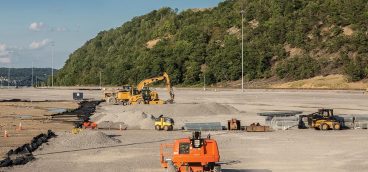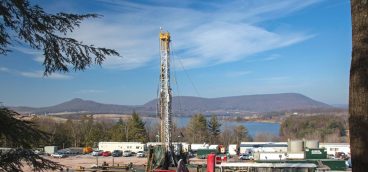
Aris Candris is not what you might expect. He skis black diamonds and enjoys snorkeling, scuba and free diving. On any given Sunday, he’ll jump on his bike and ride the hills of western Pennsylvania with no particular plan in mind.
A perfect evening must include a great cigar. He and his wife value the time off they spend every year in Greece.
The CEO of Westinghouse Electric Company holds an important key to the future of the world’s energy supply and to the future of Pittsburgh. An exceptionally modest man, whose wife Laura is a nationally recognized employment attorney, Candris grew up in Greece, went to college in Kentucky, and earned his doctorate in nuclear engineering from Carnegie Mellon University. Starting his career as a senior engineer in the Advanced Reactor Division, he has worked at Westinghouse for more than 30 years.
Candris was applying his knowledge of nuclear physics at a time when the world was frightened by anything nuclear, but he kept his eye on the future. When the oil crisis hit in 1973, Candris knew the world’s long-term energy needs must eventually depend on nuclear power.
Back then, the timing wasn’t right. Today it is.
Over the last 120 years, the timelines for Westinghouse and the Pittsburgh region have followed a parallel course. Both boomed for the better part of the 20th century, fell into decline, retooled, and are now poised to make their mark again. Candris sat down with me to explain why he believes Westinghouse is at its best point in decades. As western Pennsylvania seeks economic development opportunities amid the current chaos and massive downsizing, the story of Westinghouse offers important lessons.
Alternative energy
It’s no secret that everyone everywhere is contemplating alternate forms of energy. One of the best and cleanest alternate forms already in place is nuclear energy, and Westinghouse leads the world in technological superiority. The crown jewel is its AP1000™ nuclear reactor, which has only half the moving parts of other reactors. Its passive safety systems, which do not require external power to operate in an emergency, provide the AP1000 design with unique safety and operational advantages.
Creating the world’s most advanced nuclear reactor was not by luck. An economic downturn in the U.S. after the Three Mile Island accident (1979), combined with the Chernobyl disaster in 1986, slowed development of and support for nuclear power around the world. For nearly 20 years, Candris and his colleagues hoped for some external event (perhaps runaway oil prices?) that would give nuclear energy a second chance. “For years we scrounged, set up our own secret ‘skunk works’, and diverted corporate resources so we could fly under the radar and hopefully come up with a better nuclear platform,” Candris said with a laugh.
Apparently it worked; so far China has signed up for four AP1000 units with the promise of more. The AP1000 has been identified as the technology of choice for six new U.S. reactors, including the only six for which engineering, procurement and construction contracts are signed. The company is also pursuing new reactors in the United Kingdom and South Africa, while continuing to invest in its core fuel and services businesses.
The strategic advantage of leading-edge nuclear technology is obvious, but the role played by the new owners is not. In 2006, former owner BNFL (British Nuclear Fuels) sold Westinghouse to a consortium headed by Japan’s Toshiba Corp. and two minority investors. The $5 billion price deal was a long-term, strategic bet by the new owners and a key step for Westinghouse.
As Candris said, “If we had not been under our current ownership and management, we likely could not have achieved our current level of success.” In order to bid on major projects such as the Chinese deal, a company needs the financial resources to guarantee it can perform on time. “That is why having a parent company like Toshiba that understands global business practices and invests in technology development can make all the difference.” As it turned out, Toshiba not only made a good bet on Westinghouse, but at the same time Toshiba’s heavy equipment group, which makes turbines and nuclear equipment, has found expanded opportunities with Westinghouse’s nuclear projects.
Staying in Pittsburgh
The rumors circulating several years ago about Westinghouse possibly moving its operations out of our region were true. “Without meaningful economic support from the Allegheny Conference and incentives from local governments and the Commonwealth, we may well have decided to move south because of very attractive packages offered by other states,” Candris said.
The loss of Westinghouse would have been devastating, and the outcome argues that government incentives work.
And, almost unheard of these days, Westinghouse is adding to its workforce. Candris is almost apologetic when he explains that dealing with healthy growth is one of his major daily challenges. “That almost sounds like we don’t appreciate what we have,” he said. But with senior employees approaching retirement, bringing in new people is critical. In the last three years, Westinghouse has hired more than 4,000 people, bringing its workforce to over 11,000. Working in nuclear energy isn’t “flipping hamburgers,” Candris said. Nearly 80 percent of Westinghouse employees have experience in power, fossil fuels and energy supply. Most possess bachelor of science degrees or better.
The Commonwealth and local governments are wise to keep in touch with their needs. One of those is a highly educated workforce. It’s also important to view foreign investors like Toshiba as partners in greater Pittsburgh’s future.
If you happen to run into Candris on the slopes or spot him on his weekly bike ride, give him a thumbs-up. In a ferociously competitive world economy, technology companies are in huge demand. And Westinghouse remains a Pittsburgh company.






